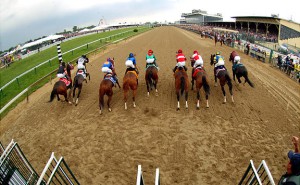Kentucky Derby Runners Typically Perform Well in Preakness
Horses that run in the Kentucky Derby have performed really well in the Preakness over the past quarter-century. In fact, 24 of the past 27 Preakness winners ran in the Derby.
The only exceptions that came in the 21st Century: Rachel Alexandra, ’09; Bernardini, ’06; and Red Bullet, ’00.
Four Derby champs the past decade were successful at Pimlico: Big Brown, ’08; Smarty Jones, ’04; Funny Cide, ’03; and War Emblem, ’02. Two others ran second: Mine That Bird ’09 and Fusaichi Pegasus in ’00.
Three others that failed at Churchill Downs during the same decade triumphed two weeks later: Curlin, ’07; Afleet Alex, ’05; and Point Given, ’01.
In ’05, during one of the more exciting races, Afleet Alex overcame near disaster in the stretch. The son of Northern Afleet, third in the Derby, came flying around the far turn with dead aim on pacesetter High Limit, but was blocked.
Suddenly Scrappy T, racing second in front of him, bore out in the upper stretch. Afleet Alex stumbled, buckled to his knees and Jeremy Rose was almost unseated. Both quickly recovered their balance and the colt zipped inside Scrappy T, sticking his head in front a furlong from the wire. Afleet Alex drew off and won by 4 ¾ lengths.
Newcomers had their greatest series of performances in the early ’80s. Three horses that skipped the Louisville race captured the second jewel of the Triple Crown: Deputed Testimony, ’83; Alomas’s Ruler, ’82; and Codex, ’80.
Preakness favorites haven’t let down the betting public during the past 22 years, winning 10 times, including nine that exited the Derby. Double-digit winners have been few and far between – only 11 since ’75 when the longest shot in history, Master Derby, returned $40 on the front end.
Wagering on the Preakness should depend on the formula you use to handicap stakes races: form, class, race conditions, connections, etc.
First and foremost, as far as I’m concerned, any contender should exhibit form, plus necessary morning workouts since the last outing.
For example, 3-year-olds that haven’t raced in more than 30 days should show a work at Pimlico and ample evidence they have a history of performing well off short or long layoffs.
Class is important, but a tricky part of the puzzle. I believe runners that performed well against first-rate foes in recent races merit consideration. However, those that benefited from easy pace figures against lesser rivals should send up a red flag.
It’s a good idea to visualize how the Preakness will be run: who the front-runners will be, what contenders will be stalking and which runners have the best chance of closing.
One myth perpetuated over the years ballyhoos Pimlico as a speed-favoring surface with sharp turns that favor front-running horses. Actually, the turns are almost identical to Churchill Downs.
However, keep in mind horses in the lead turning for home have the edge since the stretch is 168 feet shorter that Churchill Downs’ 1,320 feet.


